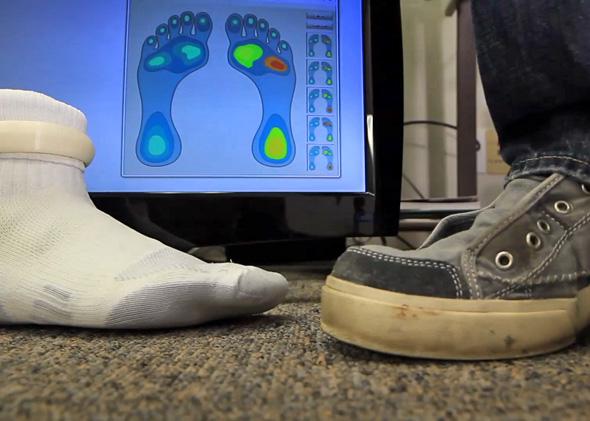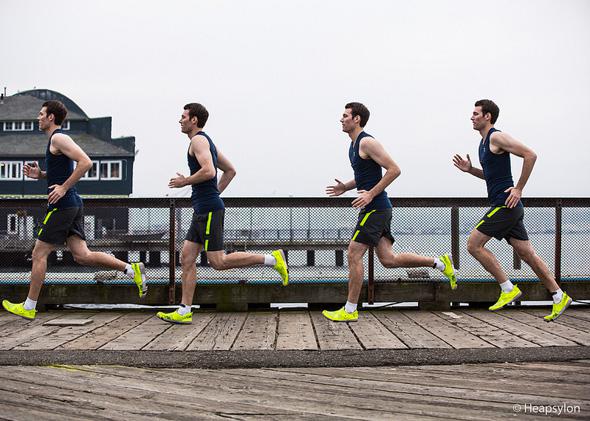This week, Slate is reviewing all the “smart” gizmos we can get our hands on. Read all the entries here.
When the email appeared in my inbox, I thought it was a joke. Smart socks? For $150? The concept sounded, well, the opposite of smart.
That impression did not diminish when I saw a prototype of the socks—or, rather, the sock. (Only one in each pair is blessed with intelligence.) At first glance, it’s just a regular old cotton sock, but with a whitish, plasticy, curved band stuck to it via a pair of metal snaps. Look closer and you’ll notice a discolored patch on the bottom, with a thread running up to meet the plastic band. The iPhone of ankle-wear, this is not.
Then again, it’s just a prototype at this point, developed by a small startup called Heapsylon whose co-founders left Microsoft to try their hands at smart apparel. So when co-founder Maurizio Macagno offered me a demonstration, I resolved to hold the mockery and give it a chance.
The Sensoria smart sock, I found, is not nearly as dumb as it looks.
On one level, it’s like a Fitbit or Fuelband for your foot: It can count your steps, track your altitude, and tally how many calories you’ve burned while walking or running. It sends the data to an iPhone app, which can store your stats, plan your workout, analyze your progress, and give you audible alerts as you run. Because it’s on your ankle, Macagno says it’s more accurate than traditional fitness bracelets, which have to try to infer your steps based on your arm movements.
But the real magic isn’t in the plastic anklet. It’s in that discolored patch on the bottom of the sock itself. Macagno explained to me how his co-founder, Mario Esposito, hit on the core idea behind the startup: “He was trying to find a way to change the characteristics of fabric to make it sensitive to certain biometric indicators. He spent a lot of time with his wife in the kitchen with chemical ingredients—he burned the ceiling of the kitchen a couple of times. And then at some point he hit the right formula.”
In short, Esposito figured out how to make fabric itself into—in essence—a variable resistor. The more force is applied to it, the more energy it conducts. So by sending an electronic signal from the ankle bracelet down through the chemical-treated fabric and back, the smart sock can gauge the amount of pressure you’re putting on different parts of your foot with every jump. It can tell whether you’re walking, jogging, sprinting, jumping up and down, or just shifting your weight—and send that information to your iPhone in real time.
As a result, it can tell you more than just how much you’re running. It can tell you how you’re running. And that makes it attractive not only to fitness buffs, but to physical therapists and podiatrists. Instead of simply assessing a patient’s foot once before fitting an orthotic device, they can watch it in action over time. “It’s like having a movie rather than a picture,” Macagno says.
As Americans have started to move from plush, deeply cushioned running shoes to more minimalist footwear, Macagno says, many have failed to adjust their running style accordingly. The smart sock can detect which part of your foot is hitting the ground first, and how hard. If it’s your heel, rather than your forefoot, it can trigger a warning from your iPhone app: “For the last 10 meters, you have been heel-striking. Please adjust your weight forward,” it intones. If you fall behind your target pace according to the app’s metronome, it can say, “You’re losing your cadence. Speed up now.”
The sock is machine-washable up to 30 times, which would seem to limit its lifespan as an everyday device. Macagno says the company is working on ways to make them last much longer, and in the meantime you can buy a pack of three replacements for $59.

Courtesy Heapsylon LLC
Heapsylon’s crowdfunding campaign for the Sensoria sock this past summer was a success: Aiming to raise $87,000, it pulled in $115,000 in a little more than two months. The first socks will ship next March, and the company plans to use the cash from those early adopters to develop more refined versions of the product in the months to come.
And socks, it turns out, are just the beginning of Heapsylon’s plans for smart clothing. They’ve already developed a smart T-shirt and smart sports bra that can measure your heart and breathing rates. Ultimately, Macagno predicts clothing will become like “your very personal computer.” He says, “The stuff you wear will be infused with sensors that aren’t even visible to you, but they can collect data from you or from the environment. And they can either act directly on the garment or transmit the data to hubs, whether it’s your smartphone, a smart watch, your Google Glasses, or anything.”
